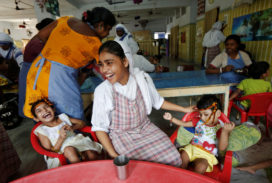
By Annie Kendzierski
It was close to midnight as we neared our destination and we struggled to fight off the creeping waves of exhaustion and hunger that threatened to sweep us under the current.
Combined with the discomfort of spending the last six hours in the Middle Eastern sun, it seemed almost impossible to wrap our heads around the moments awaiting us.
Upon entering the orphanage, a mother placed her young child into my arms. She was a resident of the orphanage where the common room is a room with walls painted too yellow, making the absurd scarcity of furniture poignant.
The introduction, in Arabic, was somewhat decipherable to my foreign ears as I was able to catch the young girl’s name above the noise of the other children, eager to see Americans with green eyes and blonde hair.
The girl’s curls, held up in two ponytails around her ears, bounced as she attempted to stuff the pink dog shaped balloon into her mouth to feel the sensation of the latex bursting between her cheeks.
I lifted her up slightly above face level as I watched this young girl’s once stoic expression turn into a smile that grew across her cheeks, crinkling the corners of her eyes, and the unadulterated joy that radiated through her countenance.
‘Garbage City’
The orphanage is located minutes from Manshiat Naser, a city in Cairo that is more commonly known as “garbage city.” The town acquired this name from the heaping piles of landfill that tower over the two-story homes and pave the streets that were once gravel.
Without a formal sanitation system and means of running water, inadequacies swarm the towns infrastructure. Within the dimly lit facility, there are rooms that hold up to six children, yet a maximum of three cots will be found in each.
Along with the beds is either a cabinet or a table for the children’s belongings, but no storage for clothing or toys, both of which we saw none of. The bathroom is communal and lined with dust and residue, with no sign of running water.
A little over 6,000-miles away, a similar situation exists. Surrounded by miles of greenery and jungle-like terrain, a halfway house for young children in Kingston, Jamaica, is home to dozens of youth.
Whether their guardians were found guilty of substance abuse or have been incarcerated, these children are taken in by “aunties” – women who devote their lives to being of aid to these children.
The halfway house was smaller than the orphanage in Cairo, having only one floor, as opposed to three. It has assets such as running water and plumbing, but the shortage of beds remains a constant for these children. In both cases, the establishment’s condition reflected that of the environment they were inhabiting.
Inspired To Help
I aspire to be an urban planner in cities like Cairo and Kingston to make sure that all care facilities, not only orphanages and halfway houses are given as much care as they are giving to the people that are taken in.
Establishments such as halfway houses and orphanages need to be placed in stable environments that are capable of tending to their needs.
I will work toward reaching the goal of making sure that all foundations meant to provide stability are placed in areas that have adequate resources to make the mission of caring for those in need possible.
I dream of improving the quality of these buildings, from installing plumbing to harvesting money in community budgets for additional beds in orphanages.
It was these children, the ones without their own bed and running water that changed my life, and I intend on returning the favor.
Kendzierski is a senior at The Mary Louis Academy, Jamaica Estates. She spent time doing service work in Egypt and Jamaica as part of mission trips with her church. She and her youth group travel abroad to work in day camps and homes for the disabled and the elderly. She started serving at 13 years old.
